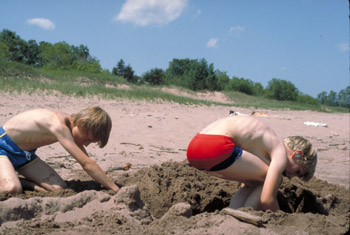Editors note: Congress is considering a $475 million appropriation for Great Lakes cleanup. This story is part of an occasional look at proposals for how to spend it. Is this an appropriate use of these funds? Weigh in on this and other ideas or suggest your own on Echo’s Great Lakes Restoration Initiative forum. Other stories.

The Great Lakes Restoration Initiative would give $12 million to keep beaches bacteria free. Photo: Minnesota Sea Grant
By Allison Bush, bushalli@msu.edu
Great Lakes Echo
July 21, 2009
Getting buried in the sand at the beach is a childhood rite-of-passage that could have negative consequences.
Children could also be playing with bacteria and viruses that can lead to vomiting or diarrhea.
A University of North Carolina researcher recently found that digging in sand led to a 13 percent increase in gastrointestinal problems following a day at the beach. Getting buried in it led to a 23 percent increase.
Three of the seven beaches tested were on Lake Michigan; one was on Lake Erie. The others were in Mississippi, Alabama and Rhode Island.
“There’s been a lot of discussion about bacteria on beaches, but there hasn’t been a lot of money, so people haven’t been doing much,” said Holly Wirick, a beach program coordinator for the Environmental Protection Agency.
Until now.
Congress is considering a $475 million appropriation for a variety of efforts to clean up the Great Lakes. A group of state and federal agencies offering advice on divvying up the money suggests using $12 million of it to identify and remove beach bacteria sources.
Public hearings on how to use the $475 million start today.
“We don’t know what’s going to happen in Congress, but we have great ideas for what we’d like the money to be used for,” Wirick said.
Part of the $12 million would go toward Beach Sanitary Surveys, something that the city of Racine, Wisc., has used for several years, Wirick said.
“It’s a quest to identify pollution sources and identify water quality,” said Julie Kinzelman, lab director for the city of Racine’s Health Department. “We have student interns that go out and do routine checks of the beaches, and also do a more in-depth annual survey.”
The surveys can cost up to $9,000 per beach, Kinzelman said. The results help identify contamination sources, which make it easier to clean them up.
Beach contamination comes from a number of sources, including birds, boats and sanitary sewer overflows.
Racine has taken several steps to reduce bacteria – altering the slope of the beach to improve drainage, constructing wetlands and changing how the beach is groomed.
That’s helped keep swimmers in the water.
“We had 32 days of water-quality advisories in 2005,” Kinzelman said. “But since that time, we’ve had a yearly average of about three.”
Birds are a primary bacteria source identified in the Great Lakes Restoration Initiative that Congress is considering. Elizabeth Alm, a professor of microbiology at Central Michigan University, has been looking at how to reduce the number of gulls on Great Lakes beaches.
Approximately 30 percent of beach closings cite gull waste as a contributing factor, Alm said.
Because the gulls are warm-blooded, they can carry microorganisms in their intestines that could cause human illness, she said. These can get deposited on the beaches through their feces.
And the number of gulls on beaches is increasing. They’re attracted by landfills and by people who leave trash on the beach, Alm said.
Alm has proposed using border collies to chase off the birds. They have been successful with chasing off geese. But geese are fairly easy to chase off; gulls tend to just fly up and then come back down, she said.
“Border collies can become frustrated if their work is not successful,” Alm said. “So we wanted to study the gull movement patterns to see if we could time border collie presence to be most effective and least frustrating.”
Alm and other Great Lakes researchers could apply for funding for measures to control bacterial pollution if Congress approves Great Lakes Restoration Initiative.
The Environmental Protection Agency has a guide for applying for such funding.
There are also more simple ways to help reduce the contamination, Wirick said.
“We want to ask people to make sure their septic systems are working properly, and not to feed the birds,” she said. “We also need to make sure there’s plenty of (bathrooms and trash cans) on the beach.”
Weigh in on this and other ideas or suggest your own ideas for $475 million in Great Lakes restoration on Echo’s Great Lakes Restoration Initiative forum.